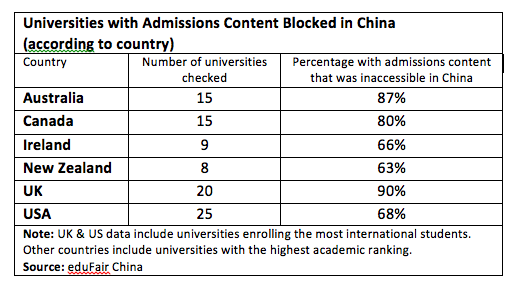You have /5 articles left.
Sign up for a free account or log in.
Every spring, thousands of young Chinese students line up outside a shopping mall on Shanghai's fashionable Nanjing West Road. They glance at their phones while following a maze of barricades and laminated signs. These students are not lining up for a sale or product launch—they are patiently waiting for a visa interview at the American Consulate.
.png)
There are similar lines at consulates for the UK, Canada, Australia, New Zealand, and more. As China has rapidly developed, Chinese parents have become increasingly concerned about the accessibility of higher education in China. At the same time, Western institutions are facing decreasing domestic enrollments and shrinking budgets. The two trends have allowed China to claim the top-spot as the country sending the most students abroad. According to state-run Xinhua News, nearly 1.7 million Chinese students were studying abroad in 2014.
However, even with record enrollment, admissions staff face difficult barriers in reaching Chinese students. Beyond the Trump administration’s travel ban and changes in international students’ perceptions, China operates the largest internet screening gateway in the world, often called the Great Firewall of China. The filtering of content is unpredictable and strict: in Freedom House's 2015 survey, China ranked dead last in terms of internet openness.
Because of internet censorship, it is tricky to know what content can be seen by prospective Chinese students. Western staples like Google, Facebook, Twitter, and YouTube are banned in China.
Meanwhile, outside the consulate, the students stand in line imagining their lives abroad. Often, if they navigate to a university's admission website, their browser will return, "Unable to open page."
Even institutions with long track records of recruiting Chinese students struggle to provide accessible content. For example, of the top-25 universities in America enrolling the most international students, 68 percent had admissions content that was blocked in China. While some schools were missing secondary content, such as student interviews or campus photos, other schools had entire admissions pages that were inaccessible.
 With more than 520,000 Chinese students going abroad last year, there is increasing interest and competition in recruiting in Mainland China. Currently, many institutions rely on recruiters and agents. These recruiters receive commissions from schools once students have been placed. Further, the families of the students pay large sums—often as much as $10,000—for the agents' services.
With more than 520,000 Chinese students going abroad last year, there is increasing interest and competition in recruiting in Mainland China. Currently, many institutions rely on recruiters and agents. These recruiters receive commissions from schools once students have been placed. Further, the families of the students pay large sums—often as much as $10,000—for the agents' services.
This overreliance on agents has created far-reaching problems. As witnessed through recent stories about New Oriental and Dipont Education, there is economic incentive for agents to falsify students' transcripts, essays, and recommendations. Because the agents act as middlemen, it is difficult for schools to assess the authenticity of students' credentials. Meanwhile, because of blocked content, Chinese students find it difficult to navigate the world of foreign admissions, and they feel they are at a disadvantage without an agent.
Utilizing the Internet as a Recruitment Tool in China
In the face of agent fraud and tight finances, schools have further turned to the internet as a free and direct medium for connecting with students. At the same time, both Chinese parents and students cite the internet as a chief source for finding information about overseas institutions. However, there are cultural and technological concerns that admissions representatives must keep in mind.
Due to cultural concerns of fraud, Chinese internet users who see missing content or a broken link are likely to regard a website as unreliable. Also, compared to Western students, a Chinese student's decision to study abroad is more heavily influenced by parents, relatives, and friends. (This derives from the Chinese concept of guanxi through which business deals and trusted advice stem from networking.) Even though students may be able to navigate English websites, their parents and influencers may not. For these reasons, using local sites in the local language are much more effective recruitment strategies.
Moreover, because Chinese internet filters operate on changing and seemingly random rules, it is best for schools to upload admissions content to a China-specific site. Even small changes to an institution's domestic site—a new Instagram link or a paragraph with a sensitive trigger word—can block or severely slow down access in China. In turn, many institutions have started to utilize Chinese social networks to communicate with students.
Below is a short list of tips for utilizing social media in Chinese student recruitment:
- Localize - For institutions, the two most popular Chinese platforms are WeChat and Sina Weibo. With more than 800 million active users, WeChat is an instant messaging service that allows schools to push news and updates to subscribers. Weibo is a microblogging site that combines features similar to Facebook and Twitter; schools can maintain a personal page while sending posts to followers. While WeChat requires organizations to be registered in China, Weibo accounts are open for all users.
- Speak the language - Don't translate everything. However, make sure that a student's circle of influencers can also learn about and understand the strengths of your institution. Don't forget—pictures, video, and charts are excellent attention-grabbers and avoid the translation problem.
- Focus on the push and pull - Chinese students are attracted by different factors than Western students. Student diversity and extracurriculars are less important. Post content that focuses on bigger pulls such as safety, reputation, post-grad salary, and gaining "face".
- Encourage word-of-mouth - Culturally, Chinese students put more faith in first-hand accounts. Use social media to connect potential applicants with student ambassadors and alumni.
- Interact - While campus news is important, try to post content that draws responses from followers. Ask questions. Create a photo thread. Encourage conversations between alumni, applicants, and accepted students. According to researcher and social media manager Yimei Zhu, of UK universities on Chinese social media, the schools that fostered the most interaction also experienced the most growth.
- Be current - Keep the page updated. For one, current content seems exciting. Moreover, an out-of-date page seems unreliable. (It is surprising how many large and respected universities have Weibo pages whose last entries are from 2013.)
- Just do it - If you haven't already (or if you have a page that is gathering dust), kick-start your presence on Chinese social media. Start with a monthly update to grow your followers. You don't necessarily need Chinese-speaking staff; current students are already well versed in Chinese social media and are happy to gain some hands-on experience.
In the wake of the Trump administration’s travel ban, social media will be an even more important tool in communicating with international students of all nationalities. Likes and comments can go a long way in showing that your campus remains a welcoming, vibrant, and safe community. As Inside Higher Ed recently outlined, nearly 40 percent of American institutions are reporting a decrease in international applicants—with one-quarter reporting a decrease in Chinese undergraduate applications. Thus, with visa-season around the corner, help Chinese students connect with your institution, and ensure that long lines continue to form at consulates across the world.
Derrik L. Karst is Director of International CRM at eduFair China.








